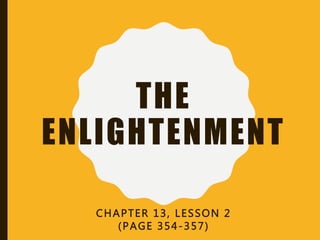The enlightenment
•Als PPTX, PDF herunterladen•
0 gefällt mir•1,120 views
looks at three philosophers
Melden
Teilen
Melden
Teilen

Empfohlen
Empfohlen
Weitere ähnliche Inhalte
Was ist angesagt?
Was ist angesagt? (19)
Andere mochten auch
Andere mochten auch (20)
Africa day 1 (david poss's conflicted copy 2015 11-12)

Africa day 1 (david poss's conflicted copy 2015 11-12)
Ähnlich wie The enlightenment
Ähnlich wie The enlightenment (20)
Unit 1 notebook constitution studend handouts modified

Unit 1 notebook constitution studend handouts modified
Mehr von David Poss
Mehr von David Poss (20)
Chapter 17, lesson 2 emancipation proclamation for website

Chapter 17, lesson 2 emancipation proclamation for website
Chapter 14, lesson 1 illustrating guiding questions

Chapter 14, lesson 1 illustrating guiding questions
Kürzlich hochgeladen
https://app.box.com/s/7hlvjxjalkrik7fb082xx3jk7xd7liz3TỔNG ÔN TẬP THI VÀO LỚP 10 MÔN TIẾNG ANH NĂM HỌC 2023 - 2024 CÓ ĐÁP ÁN (NGỮ Â...

TỔNG ÔN TẬP THI VÀO LỚP 10 MÔN TIẾNG ANH NĂM HỌC 2023 - 2024 CÓ ĐÁP ÁN (NGỮ Â...Nguyen Thanh Tu Collection
God is a creative God Gen 1:1. All that He created was “good”, could also be translated “beautiful”. God created man in His own image Gen 1:27. Maths helps us discover the beauty that God has created in His world and, in turn, create beautiful designs to serve and enrich the lives of others.
Explore beautiful and ugly buildings. Mathematics helps us create beautiful d...

Explore beautiful and ugly buildings. Mathematics helps us create beautiful d...christianmathematics
Kürzlich hochgeladen (20)
On National Teacher Day, meet the 2024-25 Kenan Fellows

On National Teacher Day, meet the 2024-25 Kenan Fellows
ICT role in 21st century education and it's challenges.

ICT role in 21st century education and it's challenges.
Micro-Scholarship, What it is, How can it help me.pdf

Micro-Scholarship, What it is, How can it help me.pdf
Measures of Dispersion and Variability: Range, QD, AD and SD

Measures of Dispersion and Variability: Range, QD, AD and SD
Role Of Transgenic Animal In Target Validation-1.pptx

Role Of Transgenic Animal In Target Validation-1.pptx
Mixin Classes in Odoo 17 How to Extend Models Using Mixin Classes

Mixin Classes in Odoo 17 How to Extend Models Using Mixin Classes
ICT Role in 21st Century Education & its Challenges.pptx

ICT Role in 21st Century Education & its Challenges.pptx
Unit-V; Pricing (Pharma Marketing Management).pptx

Unit-V; Pricing (Pharma Marketing Management).pptx
Beyond the EU: DORA and NIS 2 Directive's Global Impact

Beyond the EU: DORA and NIS 2 Directive's Global Impact
Basic Civil Engineering first year Notes- Chapter 4 Building.pptx

Basic Civil Engineering first year Notes- Chapter 4 Building.pptx
TỔNG ÔN TẬP THI VÀO LỚP 10 MÔN TIẾNG ANH NĂM HỌC 2023 - 2024 CÓ ĐÁP ÁN (NGỮ Â...

TỔNG ÔN TẬP THI VÀO LỚP 10 MÔN TIẾNG ANH NĂM HỌC 2023 - 2024 CÓ ĐÁP ÁN (NGỮ Â...
Python Notes for mca i year students osmania university.docx

Python Notes for mca i year students osmania university.docx
Ecological Succession. ( ECOSYSTEM, B. Pharmacy, 1st Year, Sem-II, Environmen...

Ecological Succession. ( ECOSYSTEM, B. Pharmacy, 1st Year, Sem-II, Environmen...
Explore beautiful and ugly buildings. Mathematics helps us create beautiful d...

Explore beautiful and ugly buildings. Mathematics helps us create beautiful d...
Asian American Pacific Islander Month DDSD 2024.pptx

Asian American Pacific Islander Month DDSD 2024.pptx
The enlightenment
- 1. THE ENLIGHTENMENT CHAPTER 13, LESSON 2 (PAGE 354-357)
- 2. REASON AND POLITICS • During the 1700’s Europe’s thinkers were impressed by advances in science that incorporated reason to solve problems. • They believed that this new thought could change politics and society. • They saw reason as a “light” that showed a new path. This is why we call the 1700’s the “Age of Enlightenment”
- 3. THOMAS HOBBES • 1651: wrote The Leviathan where he argued that an absolute monarchy was the best form of government • Hobbes believed humans were naturally violent and selfish, and therefore could not be trusted to make good decisions. • He felt that only a ruler with complete power could give the people direction and order, and required people to be loyal to their ruler. • His theory is called absolutism, since it supports a ruler with absolute, or total, power.
- 4. JOHN LOCKE • Locke believed in Natural Rights: The right to life, liberty (freedom), and property. • He believed that it was the job of government to protect the natural rights of the people. • He said that government should be based on a social contract between the people and their ruler. The government had to answer to the people. • If the government took away these natural rights, the people had a right (and duty) to rebel against that government and set up a new one.
- 5. BARON MONTESQUIEU • 1748: wrote The Spirit of the Laws where he argued that England’s government was the best due to a Separation of Powers which did not allow any branch to become too powerful. • Separation of Powers: power should be equally divided between different branches of government: Legislative (make the law), Executive (enforce the law), and Judicial (interpret the law) • Separation of powers is seen in our own Constitution and many other governments in
- 6. DISCUSSION Discuss with the people next to you and then answer on the interaction page of your interactive notebook: If you were to set up your own government, what parts of these thinkers’ ideas would you use and why? (you will not be the head of the government, you will just be a person who is a part of the country)